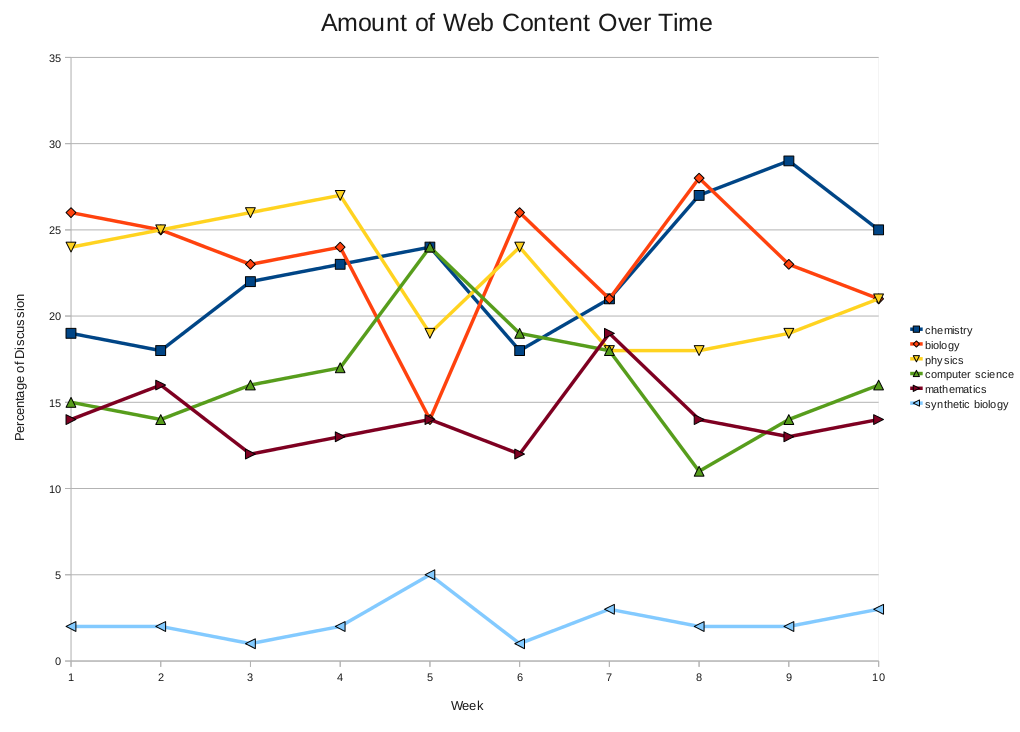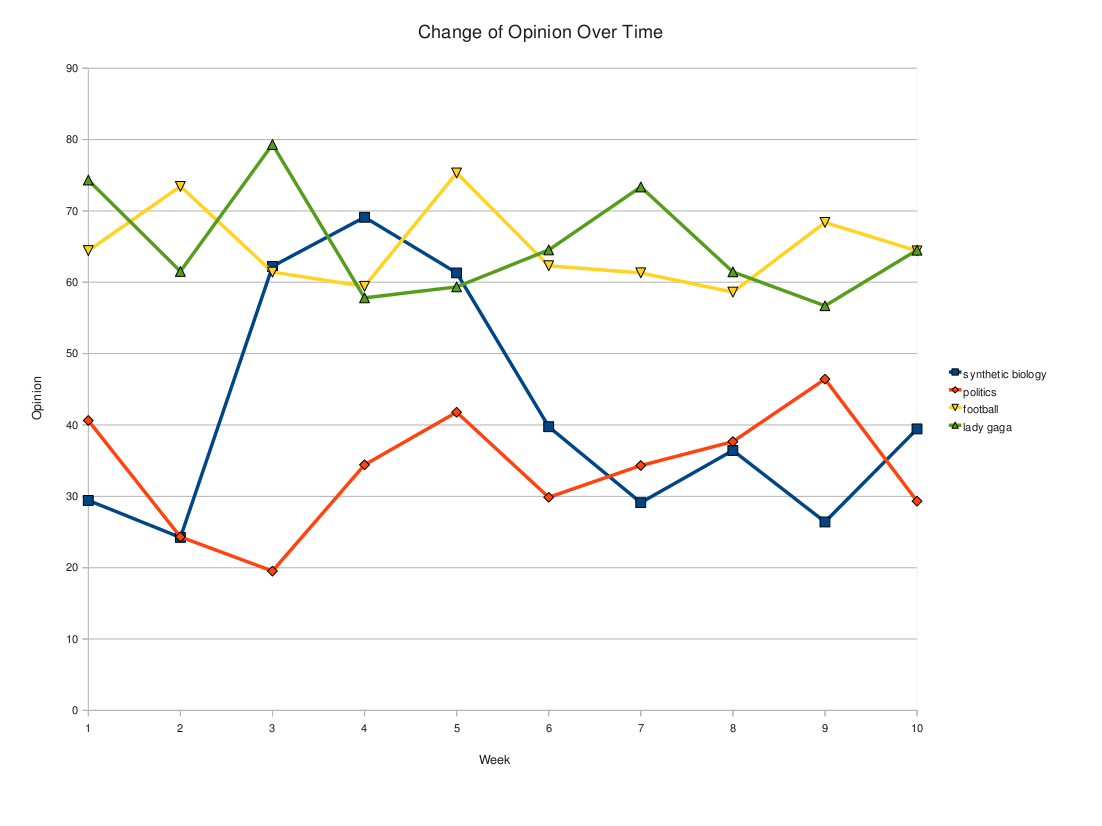Team:St Andrews/project/ethics/communication
From 2010.igem.org
(→The Opinion as to Popular Sciences and Synthetic Biology Over Time) |
|||
| Line 60: | Line 60: | ||
== The Opinion of Various Popular Culture Elements and Synthetic Biology Over Time== | == The Opinion of Various Popular Culture Elements and Synthetic Biology Over Time== | ||
[[Image:StAndrews others.png | 800px]] | [[Image:StAndrews others.png | 800px]] | ||
| - | == The Amount of Discussion of Popular Culture Elements and Synthetic | + | == The Amount of Discussion of Popular Culture Elements and Synthetic Biology over Time == |
[[Image:St Andrews Amount-other.png | 800px]] | [[Image:St Andrews Amount-other.png | 800px]] | ||
| + | Politics, footbal and Lady Gaga occur more often as Synthetic Biology. Our collected information contains sufficient subjects for a comparison. | ||
Revision as of 22:37, 27 October 2010


Communicaiton
Premise
Realtime Internet communication is increasingly common, the so called facebook generation are growing up acquainted with a dizzying array of instantaneous comunication methods. The inception of email was heralded as a revolution in communication, today the quantity of email traffic is at an all time low. In place of email instant messaging and social network messaging have come to precidence. Combined with the vast quantities of blogs, forum posts, wikis and other forms of user generated content the volume of publically accessible communications is immense. From a human practices perspective this provides a vast and frequently changing dataset which gives insight into how people communicate.
Given a moderately controversial topic such as synthetic biology this allows us to investigate a number of different metrics and trends relating to its appearance in communications. By gathering communications over a period of time we are able to investigate the following phenomena:
- How popular is synthetic biology in relation to search terms associated with popular culture (football, lady gaga, politics etc)?
- How popular is synthetic biology in relation to traditional sciences?
- How popular is synthetic biology in relation to other domain specific sciences?
If the collected data is parsed using a natural language analysis library such as the excellent [http://www.cs.pitt.edu/mpqa/opinionfinderrelease/ OpinionFinder] from the University of Pittsburgh one can draw even greater conclusions. Although the use of natural language analysis software does not guarantee accurate analysis of language it provides a good attempt. Identifying "Synthetic biology is good" as positive and "synthetic biology is evil" as negative is not a challenge, however "systems biology is excellent, unlike synthetic biology" and "synthetic biology is good at being bad" pose a greater challenge. However given training and the methodical checking of selective sets of output lessens the risk of spurious output. We are able to acquire a set of numerical figures representing the overall opinion of each collection of data. Given this we are able to analyse data gathered over a period of time to investigate the following:
- The standard deviation of opinion of synthetic biology, is opinion consistent or frequently changing?
- The standard deviation of opinion of synthetic biology compared to the standard deviation of opinion of traditional science, how do the consistence of opinions differ?
- The standard deviation of opinion of synthetic biology compared to the standard deviation of opinion of elements of popular culture, how do the consistencies of opinions differ?
Technical Solution
Theory
Before one can reap the benefits of having access to such a great pool of data one must answer the challenge of collecting this data. The web stores exobytes of data, hence collecting and parsing the entirety of the available data is simply not an option. However this is not required, when interested in a set of related terms such as {synthetic biology, synbio, igem} one can disregard large portions of the web. Furthermore if one is considering gathering data relating to social communication, then a number of start points quickly become apparent. Firstly serveral social networks offer a fairly standard XML based API and secondly virtually every so called web 2.0 site organises data via some form of chronological hierarchy (be it through metadata or simply via the removal of old articles from the home page of the site). These two features of the web allow for us to deduce a simple algorithm for collecting data. This algorithm would start at a number of popular hubs of discourse (such as large news sites, social networks, newspapers, journals, blogs etc) and procede to continue through every site linked from each site so long as a term of interest is found. Given sufficient running time this algorithm will crawl through all sites which have a path from any of the original sites. Given a sufficiently widespread set of start sites, this algorithm will encompass all sites on the web. This is not always required or (when using a remarkably generic search term) feasible and thus one may wish to impose an artificial limitation. Thus this algorithm will perform a best attempt to acquire as large a quantity of timely social communications regarding a chosen subject.
The pseudo code of the algorithm is as follows:
crawler(searchterm):
links = Stack S
S = {facebook, twitter, bbcnews, cnn, foxnews, guardian, times, nytimes .. myawesomeblog}
while S is not empty or arbritary threshold:
crawlerparser(S, searchterm)
crawlerparser(links, searchterm):
for each link in links
results = results += link containing searchterm
for each result in results
if result is old /* either is result an earlier dated result file or metadata identifies as old */
disregard
else
add all hyperlinks in result to S
output result-$(date)
This algorithm will output list of phrases extracted from the web pertaining to the search phrase. This output is then redirected to a file and serves as the input for OpinionFinder to analyse.
The following is a visualisation of the crawler algorithm:
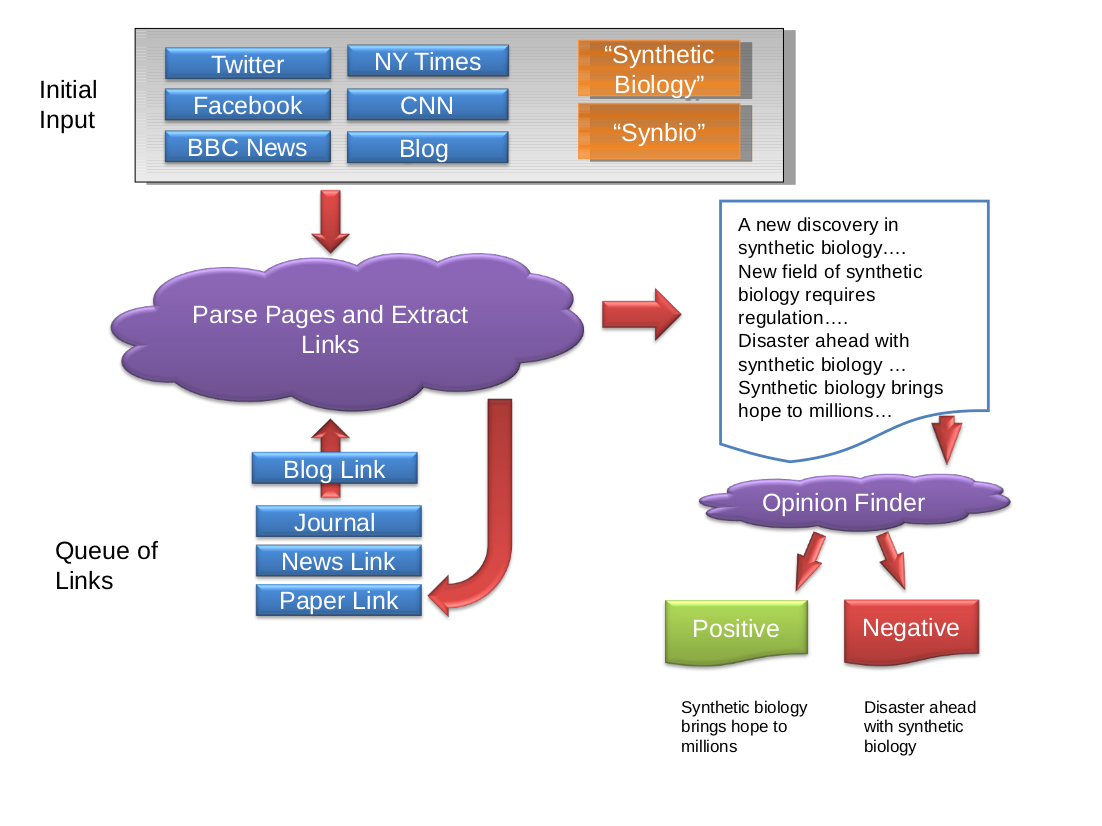
Implementation
Python Implementation of the Algorithm
Results
The following graphs are the processed output of the crawler program. The collected data was parsed and analysed. There are two types of result shown, one showing the opinion as to a subject. This is drawn from the output of OpinionFinder which examined the collected internet data. Opinion is ranked in terms of the language used to describe search terms, it is ranked from 0 to 100. Where 0 is extremely dissmisve towards a term and 100 is extremely positive towards a term. The second result shows the amount of discussion relating to a collected search term. This figure represents what percentage of the overall content crawled as part of the searching for the provided terms relate to each term.
The Opinion of Synthetic Biology and the Opinion of Genetic Engineering Over Time
The initial peak in synthetic biology is likely due to the resultant media following the sucesss of the J Craig Venter Institute in May 2010. The language used by more conventional science media is far more convervative and ranks lower thus the peak could be due to more sensationalist media coverage. This subsides after 2 weeks. Genetic Engineering alternatively is relatively constant and barely fluctuates, likes due to the lack of media coverage at the time.
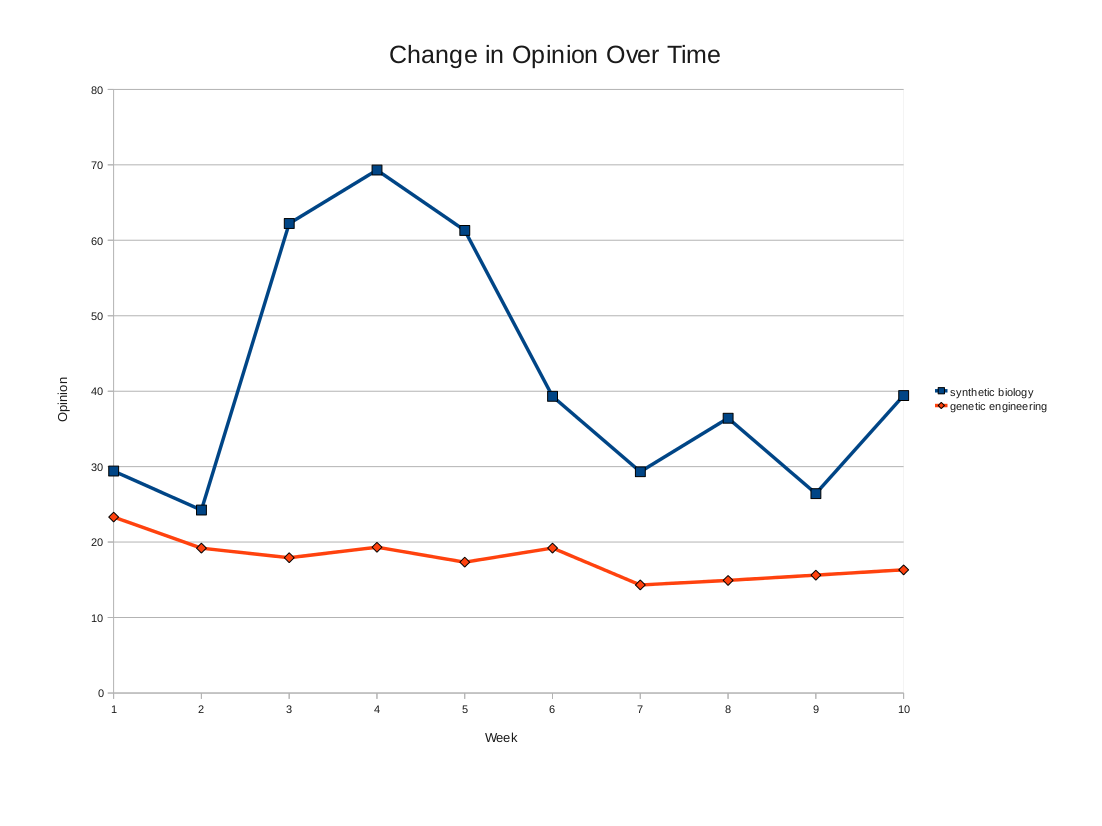
The Opinion as to Popular Sciences and Synthetic Biology Over Time
The most notable phenomena within this result is the great variation in synthetic biology when compared to tje other sciences. The three traditional sciences deviate very little, this is predomenantly due to the language used in scienctific media being relatively unbiased. Computer Science is discussed frequently in non scientific contexted and thus is subject to a wide range of dictions.
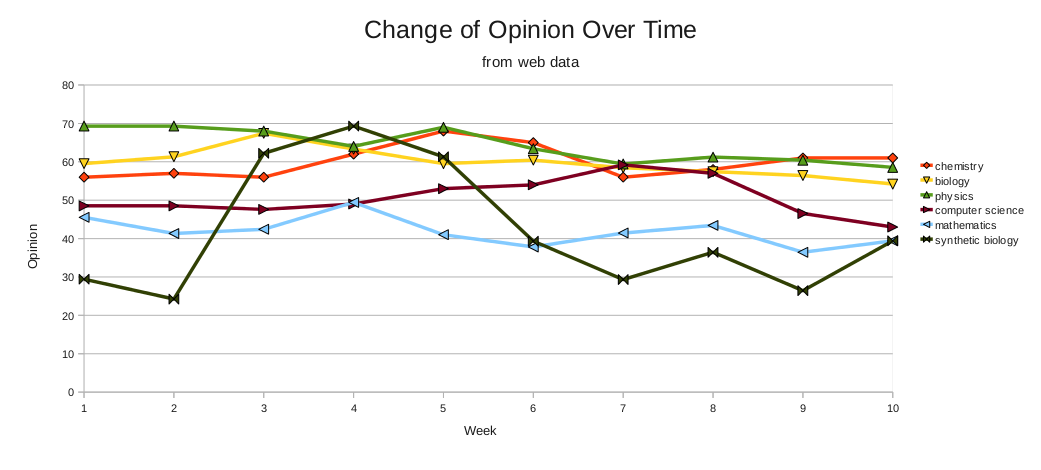
The Amount of Discussion of Sciences Over Time
The Opinion of Various Popular Culture Elements and Synthetic Biology Over Time
The Amount of Discussion of Popular Culture Elements and Synthetic Biology over Time
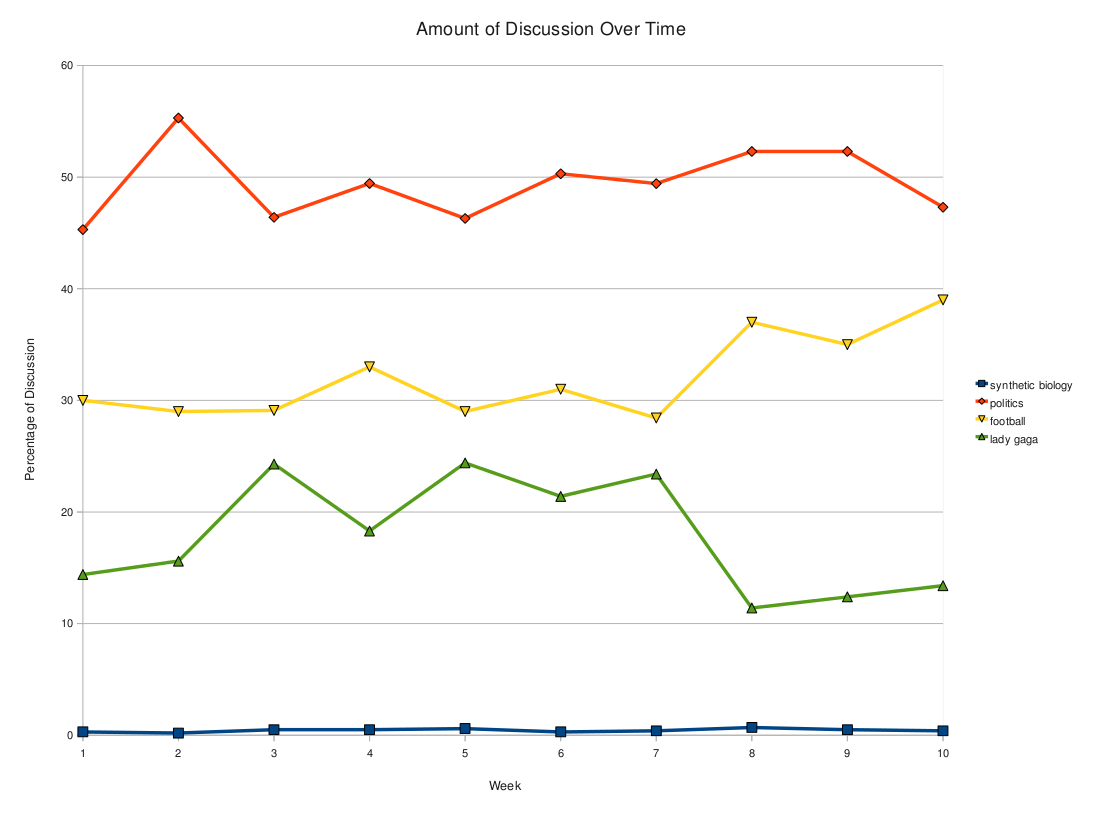 Politics, footbal and Lady Gaga occur more often as Synthetic Biology. Our collected information contains sufficient subjects for a comparison.
Politics, footbal and Lady Gaga occur more often as Synthetic Biology. Our collected information contains sufficient subjects for a comparison.
 "
"
